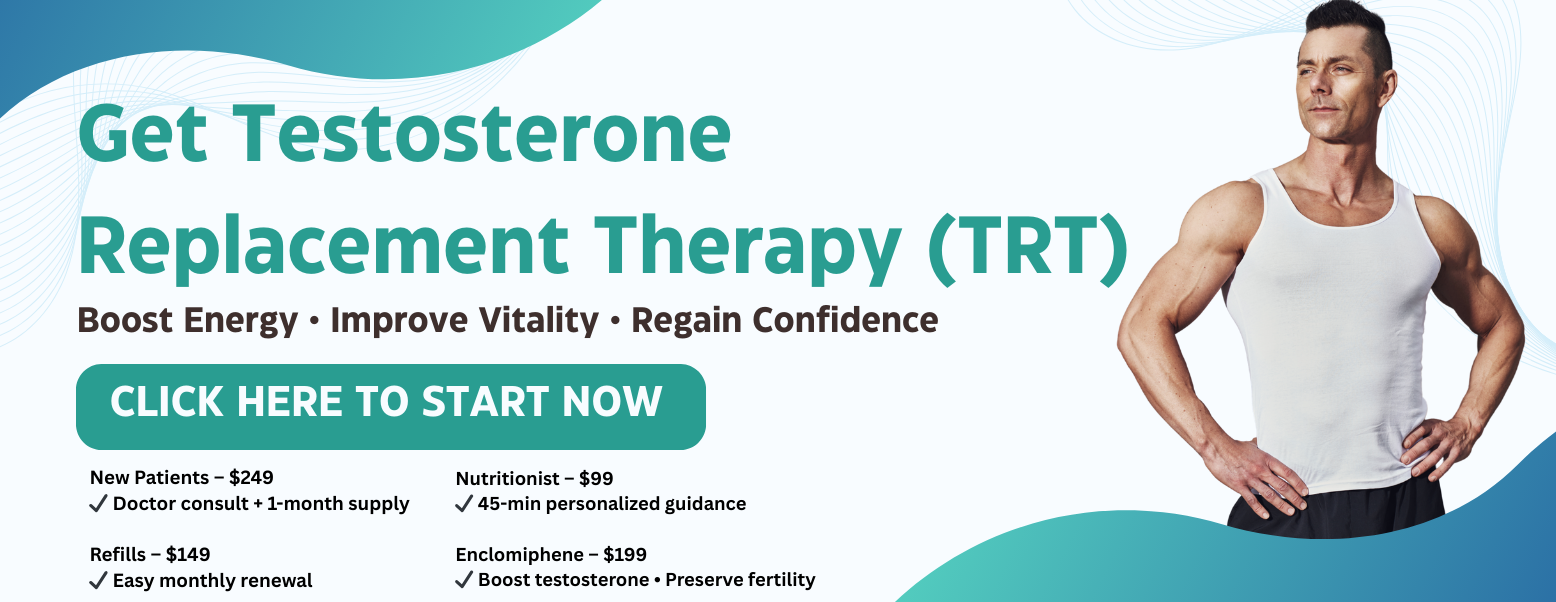Have you ever thought about how long it is going to take before your body will really feel like “you” again after starting TRT?
Testosterone Replacement Therapy (TRT) is no magic pill, but is still one of the best treatments available for men with low testosterone levels. As we mentioned earlier, it does not deliver immediate change, but with time, consistency, and proper guidance, it can improve your energy level, mood, and overall health.
Don’t Wait, Reclaim Your Vitality – Click here to Book Your TRT Consultation Now!
Generally, most men will start to notice some subtle changes between 4 and 12 weeks. Most of the benefits, from improved physical performance to a better sex drive, will generally occur within about 3 to 6 months. The experience is not always smooth. There may be some weeks when you feel better than others. However, with the correct dosage, ongoing support, and supervision from a medical provider, these results are achievable and sustainable.
In this guide, we will walk you through some of the factors that affect your TRT timeline, including when you can expect to see changes and when it's time to start making adjustments.
Are Testosterone Injections Fast-Acting?
Testosterone injections are a common method to deliver testosterone as part of TRT, but their changes are not immediate. Many men notice subtle changes, like better concentration or more energy, within the first few weeks. By Month 2, physical and sexual changes are more easily identified.
Clinical evidence indicates that long-acting testosterone injections (such as Nebido) will produce an effect in 3 weeks, at least with regard to mood and energy. However, crucial to your results will be your body's unique chemistry and adherence to your plan.
Testosterone injections must only be used under the supervision of a healthcare provider. Your age, weight, and health history will impact how your body responds. Regular monitoring will help ensure hormone levels reside in a healthy range, maintaining safety while helping optimize outcomes.
How Testosterone Levels Change with Age?
Male development is significantly influenced by testosterone, which has an impact on mood, libido, bone density, and muscular mass. In males, testosterone generally starts to go down with age, beginning in their 30s.
Unlike females, who experience a sudden drop in testosterone level during menopause, males experience a much slower decline, especially after about 1% every year. However, a few men may undergo accelerated lowering of testosterone levels or show symptoms of low testosterone in their 20s or early 30s due to low testosterone, also called hypogonadism.
Hypogonadism comes in two varieties: primary and secondary (the latter being mixed). The primary means the testicles cannot produce enough testosterone, while secondary hypogonadism means the brain is not signaling the testicles properly to produce testosterone. It is very pertinent to identify whether the testosterone deficiency is primary or secondary when considering natural and synthetic testosterone replacement therapy (TRT).
Essential Factors That Affect How Soon You See Results
It's acceptable for different bodies to react differently to TRT. The impact of TRT can be influenced by many personal and clinical characteristics that work together to inform your timeline:
Type & Dosage
The type and dose of testosterone play a crucial role, and the sooner changes are noted, the faster the process of change can occur. You don't just increase your dose of testosterone if it is not the correct dose for you. Absorptions differ not only by the method of administration but also by the amount administered. Therefore, it is essential that the treatment is individualised.
Your Biological Makeup
The body will respond uniquely to treatment, with results based on your initial testosterone levels, metabolism, hormone sensitivities, and other factors. The body will naturally take time to recalibrate and establish this new hormonal homeostasis.
Age & BMI
Younger males might notice changes faster than those who are older or greater in BMI. Nonetheless, TRT performed together with a proper fitness and nutritional plan will greatly improve results and hasten your progress.
Pre-Existing Conditions
Certain ailments in your background, such as diabetes, thyroid malfunction, or cardiovascular issues, may hinder the progress or subjective response to your TRT. This is another reason why undergoing a complete health evaluation is always important when undertaking and managing a treatment plan.
Lifestyle Choices
You will see the quickest and the best results when you commit to healthy lifestyle behaviors in concert with TRT. Regular fitness activities, healthy meals, relaxation for stress relief, and sleep all help your body be more responsive and enhance the results of TRT.
Timeline for TRT Results (Weeks to Months)
Every man's TRT is different, but every man takes a similar journey. Here is what you should expect as the weeks and months go by:
Early Adjustments - Week 1-2
By this week, you will have experienced the initial adjustment period of increased testosterone in your body. Some men report slight increases in alertness or energy levels, but usually not to the extent that you would see significant changes. Think of this as a recalibration period without results.
Noticeable Changes in Energy and Mood - Week 3-4
At week 3, it can start to feel like things are changing. Most men find that they are more balanced emotionally, less irritable, and better able to focus. Improvements in sleep may be occurring for many men, and even an increase in libido (though not a significant one at first).
Physical Changes - Month 2
By the second month of treatment, you start to see some results. If you are exercising, you may experience improvements in your strength and muscle tone, as well as reductions in body fat levels. Men generally report an even greater increased sex drive, sexual function, and mental clarity continuing into the second month.
Better Body Composition and Sexual Health - Month 3
Libido and erectile performance often improve dramatically around month three. With increasing lean muscle mass, decreasing body fat, and increasing self-confidence, you'll start to see some real differences in how you perform. You may also start to see some early improvements in bone density.
Stable and Continuous Progress - Month 4-6
At this point, the benefits of TRT are more stable. Mood, energy levels, physical performance, and libido begin to stabilize. As long as you are practising good, healthy habits and under proper medical management, you should likely start to feel the most "normal" you have felt in many years.
Long-Term Benefits - Month 6 and Beyond
Around this time, testosterone levels are probably stabilising, and you have significant improvement to your overall health. You may experience lower overall cardiovascular risks, improved cognitive health, and enhanced insulin sensitivity. Routine follow-ups continue to build and maintain momentum towards getting you optimized.
How to Maximize the Benefits of TRT
To maximize the benefit of your TRT, it is important to implement the following successful practices:
- Be consistent: Follow your schedule! Missing doses and or inconsistency can hinder your results.
- Keep a Check on your overall health: Regular blood work and health checkups allow your provider to change your treatment when necessary and keep you safe.
- Adopt a Healthy Lifestyle: Eat healthy food, exercise, sleep, and manage stress. These components will greatly enhance your results.
- Be Patient about the Outcome: Real change takes time. Some men may see results quickly and some may take several months. Stay in the course.
- Communicate with Your Healthcare Provider: Report any changes, concerns, or side effects. As your needs change, your treatment should change.
When to Reassess Your TRT Dosage
Periodically assessing your therapy is an important step in optimizing your therapy. Here is a general schedule:
- Week 6: Initial lab work and symptom assessment
- Month 3: Possible changes to the dose based on labs and your feedback
- Continuing on: Reassess every 3 to 6 months
If your testosterone level is increasing but your symptoms are not improving, it may be necessary to reassess your dosage, delivery method, or look into other markers such as estradiol, red blood cell count, or thyroid levels.
Conclusion
TRT doesn’t just happen overnight, but it can absolutely change your health and life if you continue to stick to it and follow the proper procedure. Most men notice changes in mood and energy by weeks 3-6, and changes in strength, body composition and sexual health will occur over 3-6 months.
Every man’s path with TRT will look different. What remains constant is that the successful journey includes monitoring, adjusting, and committing to the treatment. With individualized treatment, the long-term outcomes—such as improved vitality and decreased risk for diseases—could be life-altering.
Here’s What You Get With The KIF:
We provide an individualized health solution with the guidance of a physician and designed to improve your life.
- Free Consultation - $0: Get free expert responses, consultations, and a personalized plan.
- New Patient TRT - $249: Includes a telemedicine appointment with our hormone specialist and one month of starter therapy.
- Subscription for Monthly TRT: Easy refills of your testosterone, support from a physician, and very convenient ongoing care, month to month.
- TRT Refills - $149/month: Easy and constant management of your therapy with ongoing monitoring by an expert.
Schedule your free consultation today and take the first step toward feeling younger, increasing awareness and focus, improving your mood, and developing a healthier, more confident self.
 Since 2021, Kif offers a streamlined platform to get a medical marijuana card online. We have served more than 45K patients across the United States. Sign Up Now to get the right to use medical cannabis for your health condition without any delay.
Since 2021, Kif offers a streamlined platform to get a medical marijuana card online. We have served more than 45K patients across the United States. Sign Up Now to get the right to use medical cannabis for your health condition without any delay.























